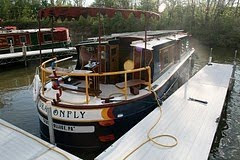 |
| Like the Olde West, but with a lakefront view |
It's probably just the architecture of the period; much of the West was settled in the second half of the 19th century, which is when St. Ignace was enjoying a bit of an economic boom, as the railroad came in.
There were even ferries that took train cars across the straits of Mackinac. The enormous ferry dock is still there on the waterfront, overgrown with weeds. Today the main economic drivers seem to be tourism and a Native American-run casino six miles up the road. Popular snacks at local restaurants: smoked whitefish and "pasties." (We tried both)
We stayed three days in St. Ignace, waiting out the weather. Each morning the forecast said, "Wind 20 knots, waves 4 to 6 feet," which is more than a canal boat can handle! Thursday morning we were up at 6:00 AM to take advantage of a good forecast. As the sun rose we were creeping out of the harbor; the moon, just past full, was high in the western sky.
A few miles down the coast we came to a landmark for the region--and a structure that marked another turning point in our voyage. As we sailed under the famous Mackinac Bridge, we officially left Lake Huron to enter Lake Michigan.







































